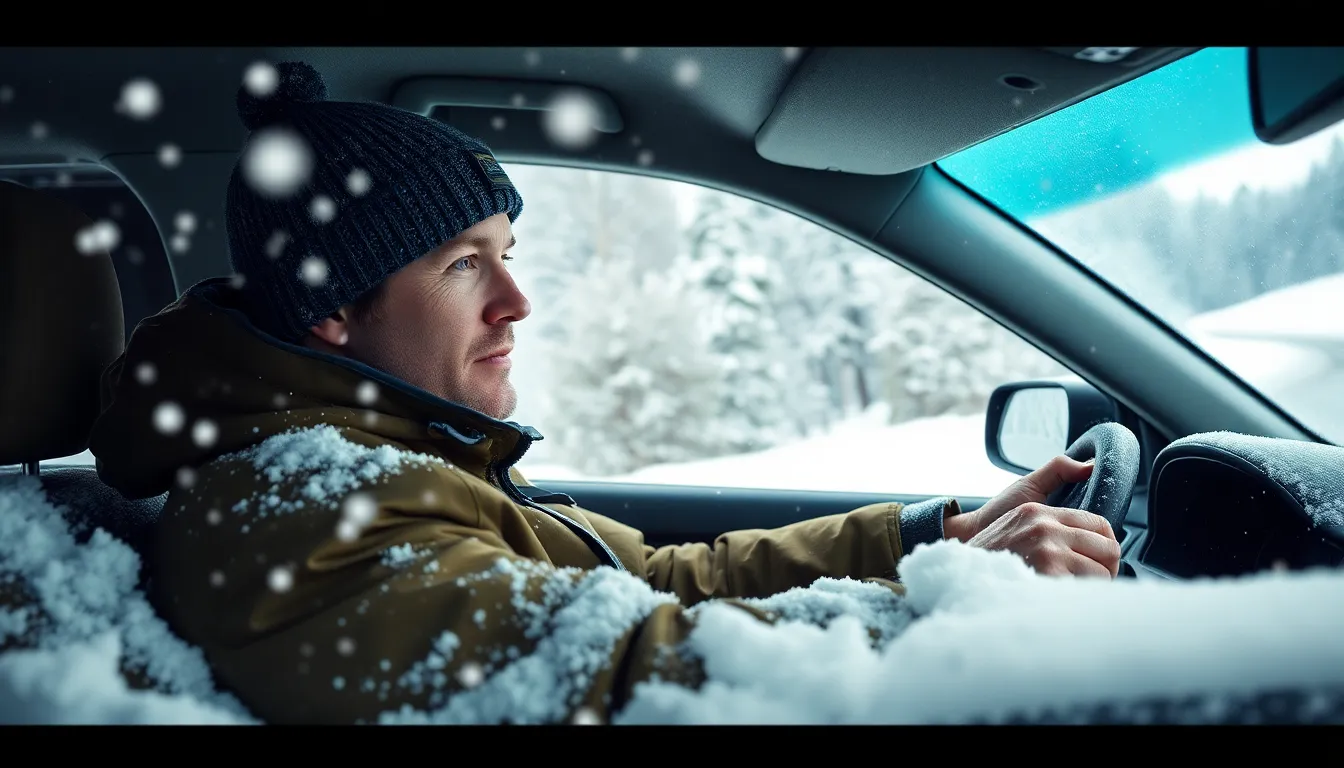Winter weather transforms our daily commute into a challenging obstacle course. When snow starts falling we’re suddenly faced with decisions that can make the difference between arriving safely or ending up stranded on the side of the road.
Driving in snow isn’t just about having the right tires – though they’re certainly important. It’s about understanding how your vehicle responds to slippery conditions mastering essential techniques and preparing for the unexpected situations winter throws our way.
Whether you’re dealing with your first snowfall or you’re a seasoned winter driver looking to sharpen your skills we’ve gathered the most effective strategies to keep you moving safely through snow-covered streets. From choosing the right equipment to mastering advanced driving techniques these proven methods will transform how you approach winter driving forever.
Choose the Right Winter Tires for Snow Driving
Selecting appropriate tires transforms your vehicle’s snow performance dramatically. Your tire choice directly impacts traction, stopping distance, and overall safety when handling winter roads.
All-Season vs Winter Tire Performance
Winter tires outperform all-season tires significantly in snow and ice conditions. Specialized rubber compounds in winter tires remain flexible at temperatures below 45°F, while all-season tire rubber hardens and loses grip. We’ve observed that winter tires provide 25-50% better traction on snow compared to all-season alternatives.
Tread patterns create the most noticeable difference between tire types. Winter tires feature deeper grooves, more sipes (tiny slits), and aggressive directional patterns that bite into snow. All-season tires use shallower treads designed for year-round comfort rather than maximum winter grip.
Stopping distances reveal dramatic performance gaps between these tire categories. Tests show that vehicles equipped with winter tires stop 30-40% shorter on snow than those using all-season tires. This difference often means avoiding accidents versus sliding into dangerous situations.
Tire Tread Depth Requirements
Legal tread depth minimums vary by location but don’t guarantee optimal snow performance. Most states require 2/32″ of tread depth, though winter driving demands much more. We recommend maintaining at least 6/32″ for adequate snow traction.
Penny tests provide quick tread depth assessments without special tools. Insert a penny into your tire’s tread groove with Lincoln’s head facing down. Visible hair on Lincoln’s head indicates dangerously worn tread below 2/32″. Quarter tests work similarly – Washington’s head should be partially covered for safe winter driving.
Professional measurements ensure accurate tread depth readings. Tire shops use specialized gauges that measure depth precisely to 1/32″. These measurements help determine whether your current tires meet winter driving standards or need immediate replacement.
Studded Tire Regulations by State
| State Category | Studded Tire Policy | Permitted Dates | Key Restrictions |
|---|---|---|---|
| Always Permitted | Alaska, Colorado, Idaho, Montana, Nevada, North Dakota, Utah, Vermont, Wyoming | Year-round | Some limit stud projection |
| Seasonal Permission | Oregon, Washington | October 1 – March 31 | Weight limits may apply |
| Limited Use | New York, Pennsylvania | October 15 – April 15 | Emergency vehicles prioritized |
| Prohibited | Illinois, Florida, Texas, California | Never permitted | Heavy fines for violations |
Regional regulations reflect local climate conditions and road infrastructure concerns. Northern states with harsh winters generally permit studded tires, while southern states prohibit them due to pavement damage. We advise checking current state laws before installing studded tires for winter travel.
Installation timing affects both legality and effectiveness of studded tire systems. Most states require removal by exact spring dates to prevent road damage during warmer months. Early installation before winter weather arrives ensures maximum benefit throughout the snow season.
Alternative traction devices offer legal options where studded tires aren’t permitted. Tire chains, snow socks, and studless winter tires provide enhanced grip without regulatory concerns. These alternatives work effectively in most snow conditions while avoiding potential legal violations.
Prepare Your Vehicle Before Winter Weather Hits
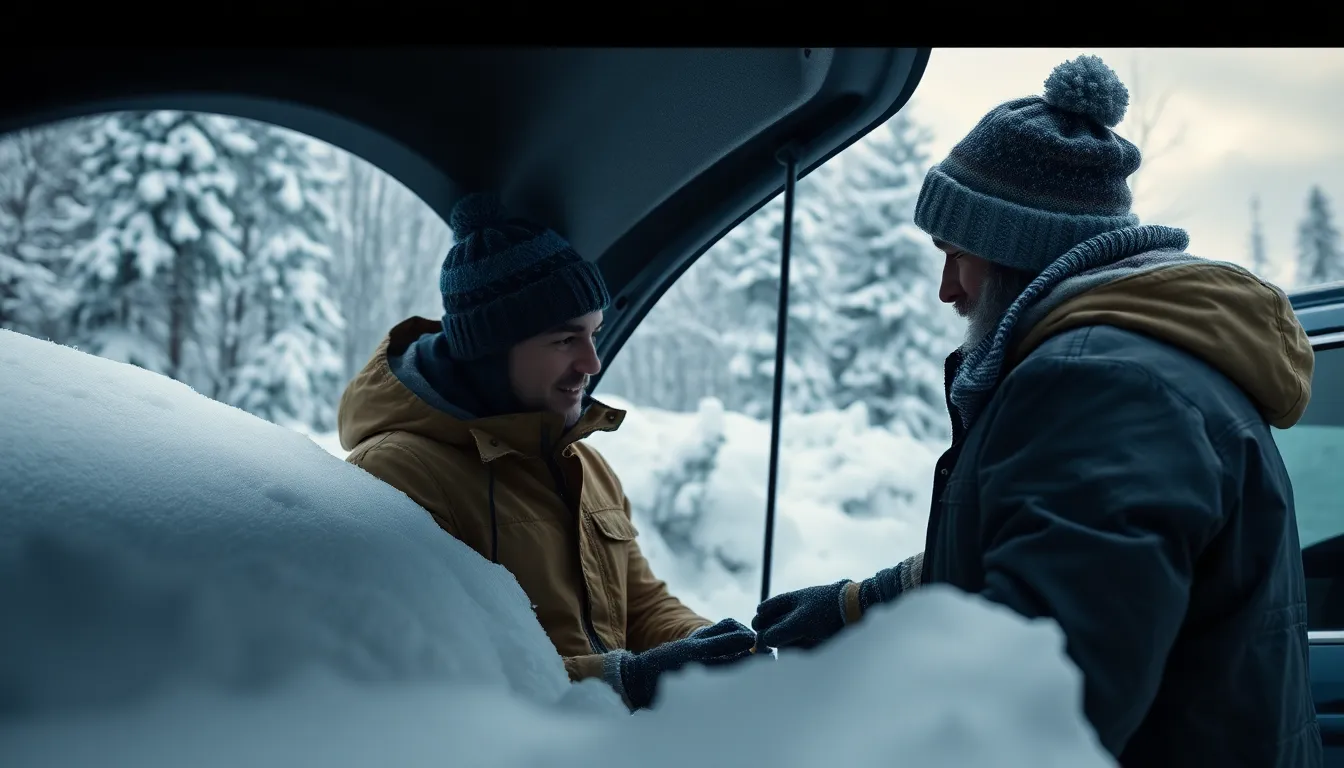
Beyond selecting the right tires and understanding driving techniques, we need to ensure our vehicles are mechanically ready for harsh winter conditions. Proper preparation prevents roadside emergencies and keeps us moving safely through snow and ice.
Essential Fluids and Battery Check
Check your antifreeze concentration levels using a hydrometer or test strips to ensure proper freeze protection. Most vehicles need a 50/50 mixture of antifreeze and water to protect against temperatures as low as -34°F. Replace the coolant if it appears rusty or contaminated.
Test your battery’s cold cranking amps since batteries lose 20% of their power at 32°F and up to 50% at 0°F. Clean corrosion from battery terminals using baking soda and water, then apply petroleum jelly to prevent future buildup. Consider replacing batteries older than three years to avoid cold weather failures.
Switch to winter grade oil with lower viscosity ratings like 5W-30 or 0W-30 instead of heavier summer oils. Thinner oils flow more easily in cold temperatures, reducing engine strain during startup. Check your owner’s manual for manufacturer recommended viscosity grades.
Fill your windshield washer reservoir with freeze resistant fluid rated for temperatures in your area. Standard washer fluid freezes at 32°F, while winter formulations protect down to -20°F or lower. Avoid mixing water with regular washer fluid as this reduces freeze protection.
Windshield Wiper and Defroster Maintenance
Replace worn wiper blades with heavy duty winter blades designed for snow and ice conditions. Winter blades feature rubber boots that prevent ice buildup on the blade frame and maintain contact with the windshield. Inspect blades monthly for cracks, splits, or missing rubber sections.
Clean your windshield thoroughly inside and out to remove film that causes fogging and reduces visibility. Use automotive glass cleaner and microfiber cloths to eliminate streaks that become magnified in low light conditions. Apply rain repellent products to improve water beading and visibility.
Test your defroster system by running both front and rear defrosters on maximum settings for 10 minutes. Check that all vents blow warm air evenly and that the rear defroster grid melts ice patterns uniformly. Replace cabin air filters to improve airflow and reduce fogging.
Inspect weatherstripping around doors and windows for cracks or gaps that allow cold air infiltration. Damaged seals force heating systems to work harder and can cause interior fogging. Apply silicone spray to rubber seals to maintain flexibility in cold weather.
Emergency Kit Assembly
Pack essential survival items including blankets, extra clothing, non perishable food, and water for each passenger. Store items in waterproof containers or bags to prevent moisture damage. Include hand and foot warmers that provide heat for up to 8 hours.
Include emergency tools such as a collapsible snow shovel, ice scraper with brush, jumper cables, and tire gauge. Add a bag of sand or cat litter for traction under tires when stuck. Pack a portable battery charger to keep cell phones powered during emergencies.
Store first aid supplies with bandages, pain relievers, and any prescription medications family members require. Include emergency contact information written on waterproof paper. Add a battery powered or hand crank radio to receive weather updates during power outages.
Keep flares or reflective triangles to mark your vehicle location if stranded on roadways. LED flashlights with extra batteries provide reliable illumination without fire hazards. Include a multi tool with knife, screwdrivers, and pliers for minor repairs or cutting seatbelts if necessary.
Master Safe Driving Techniques in Snowy Conditions
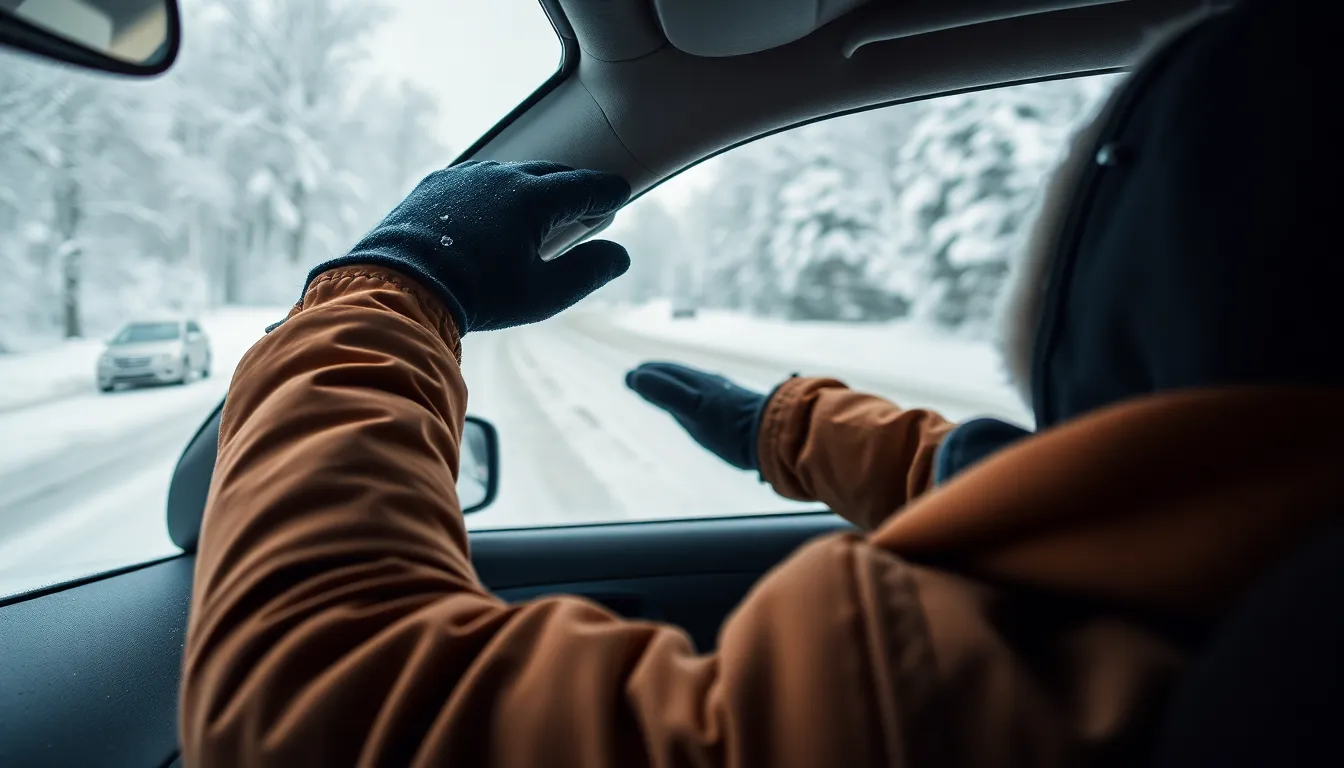
Driving on snowy roads requires exact techniques that differ significantly from dry pavement driving. We’ll explore essential skills that transform winter driving from nerve-wracking to manageable.
Proper Acceleration and Braking Methods
Gentle acceleration prevents wheel spin and maintains traction on snow covered surfaces. We recommend pressing the gas pedal slowly and steadily rather than applying quick bursts of power. Most vehicles benefit from accelerating in second gear rather than first gear to reduce torque and minimize slippage.
Gradual braking extends stopping distances and prevents dangerous skids on icy roads. We suggest pumping the brakes gently if your car lacks ABS systems or applying steady pressure if you have modern anti-lock brakes. Downshifting to engine brake provides additional stopping power without relying solely on wheel brakes.
Smooth transitions between acceleration and braking help maintain vehicle stability. We advise avoiding sudden movements that can cause loss of traction or trigger slides. Practice these techniques in empty parking lots before encountering real snow conditions.
Steering Control on Slippery Surfaces
Reduced steering inputs maintain better control when roads become slippery from snow accumulation. We recommend making smaller steering corrections rather than sharp turns that can cause the vehicle to lose grip. Oversteering often leads to dangerous spins that are difficult to recover from.
Counter steering techniques help drivers regain control during slides or skids. We suggest turning the steering wheel in the direction you want the front of the car to go while avoiding overcorrection. Practice this skill allows muscle memory to take over during actual emergencies.
Lower speeds through turns prevent lateral sliding on snow packed curves. We recommend reducing speed by 25-50% compared to dry conditions before entering corners. Physics dictates that slower speeds reduce the forces acting on tires and improve overall grip.
Safe Following Distance Guidelines
Extended following distances provide crucial reaction time on slippery winter roads. We recommend maintaining at least 8-10 seconds behind the vehicle ahead rather than the standard 3-second rule used in dry conditions. This increased buffer zone accounts for longer stopping distances on snow and ice.
Speed reduction directly affects safe following distance calculations in winter weather. We suggest using this formula: normal following distance multiplied by current road conditions factor.
| Road Condition | Following Distance Multiplier | Recommended Seconds |
|---|---|---|
| Light snow | 2x | 6-8 seconds |
| Heavy snow | 3x | 9-12 seconds |
| Ice patches | 4x | 12-15 seconds |
| Blizzard conditions | 5x | 15+ seconds |
Reference points help drivers judge proper following distances when visibility is reduced. We recommend using fixed objects like signs or bridges to count seconds between when the lead vehicle passes and when your vehicle reaches the same point. Consistent practice with these reference techniques builds better spatial awareness in challenging winter driving conditions.
Navigate Different Types of Snow and Ice
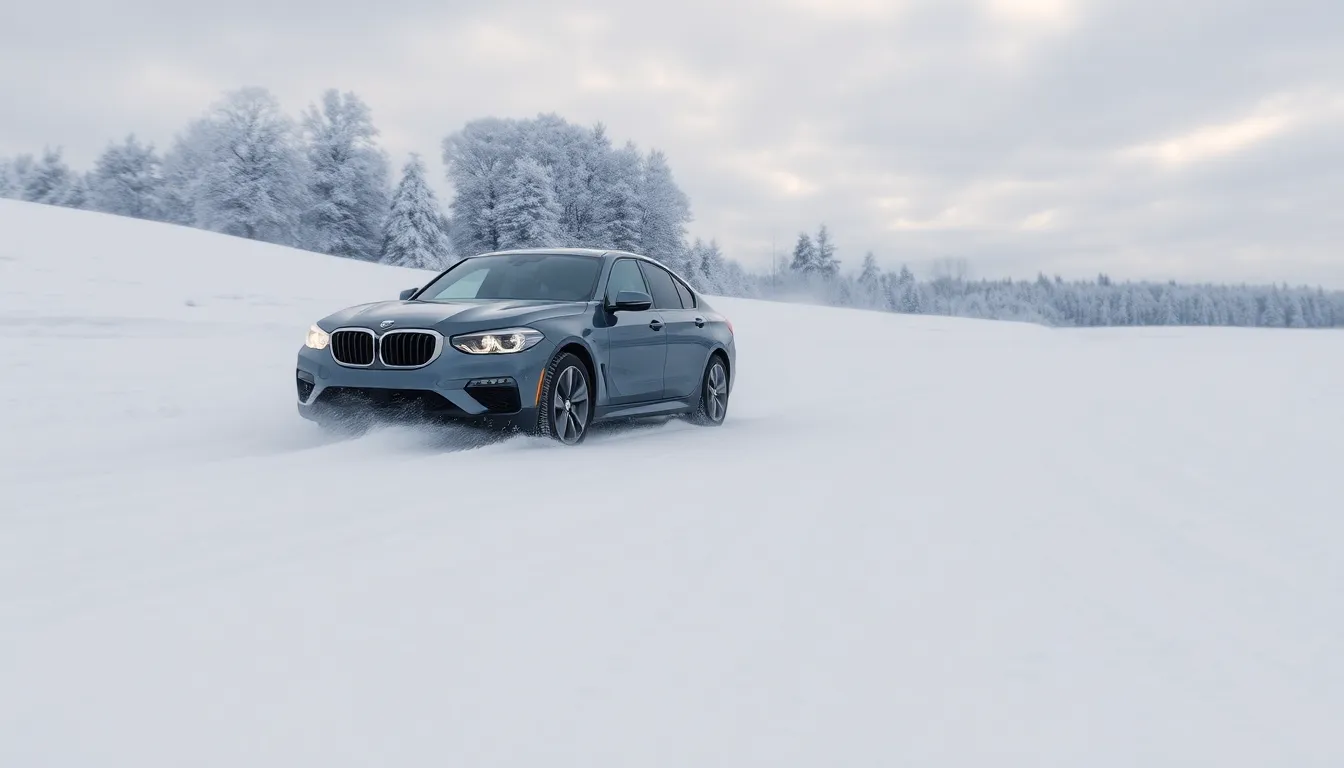
Understanding the exact characteristics of different snow and ice conditions allows us to adapt our driving techniques for maximum safety and control.
Fresh Powder vs Packed Snow Strategies
Fresh powder requires different handling than packed snow due to its unique traction properties. We should accelerate gradually through fresh snow, allowing our tires to create their own path rather than spinning. The key lies in maintaining steady momentum without sudden inputs that can cause the vehicle to dig deeper.
Packed snow presents a firmer surface but demands respect for its slippery nature. We need to reduce our speed significantly more on packed surfaces since they offer less traction than fresh powder. Gentle steering inputs become crucial as packed snow can cause sudden slides when we turn too sharply.
Testing our vehicle’s grip helps us understand each surface’s limits. We can perform this safely by gently pressing the accelerator or brake in an empty area to feel how much traction we have. This knowledge allows us to adjust our driving style accordingly throughout our journey.
Black Ice Identification and Response
Black ice appears as a shiny or wet looking surface on the roadway, particularly dangerous because it’s nearly invisible. We often encounter it on bridges, overpasses, and shaded areas where temperatures drop first. Early morning and late evening hours present the highest risk for black ice formation.
Warning signs include unusually quiet road noise from our tires or a sudden feeling that our steering has become overly responsive. We should immediately reduce speed when we suspect black ice presence. Avoid sudden movements with the steering wheel, accelerator, or brakes that could trigger a slide.
Recovery techniques focus on staying calm and making minimal corrections. We must resist the urge to overcorrect if we feel the vehicle sliding on black ice. Instead, we should ease off the accelerator and steer gently in the direction we want to go while avoiding abrupt inputs.
Slush and Wet Snow Handling
Slush creates hydroplaning risks similar to standing water but with added unpredictability. We need to reduce speed more than we might expect since slush can hide deeper accumulations or icy patches underneath. Maintaining consistent speed helps prevent our vehicle from suddenly breaking through to different surface conditions.
Wet snow sticks to our tires and can build up in wheel wells, affecting handling and braking performance. We should periodically check for snow buildup during longer drives and clear it when safe to do so. This buildup can also affect our vehicle’s weight distribution and handling characteristics.
Visibility challenges multiply in slush and wet snow conditions as other vehicles throw spray onto our windshield. We must increase our following distance even more than in dry snow conditions and ensure our wipers and defroster systems work effectively. Using our headlights during daylight hours improves our visibility to other drivers in these challenging conditions.
Understand Your Car’s Winter Safety Features
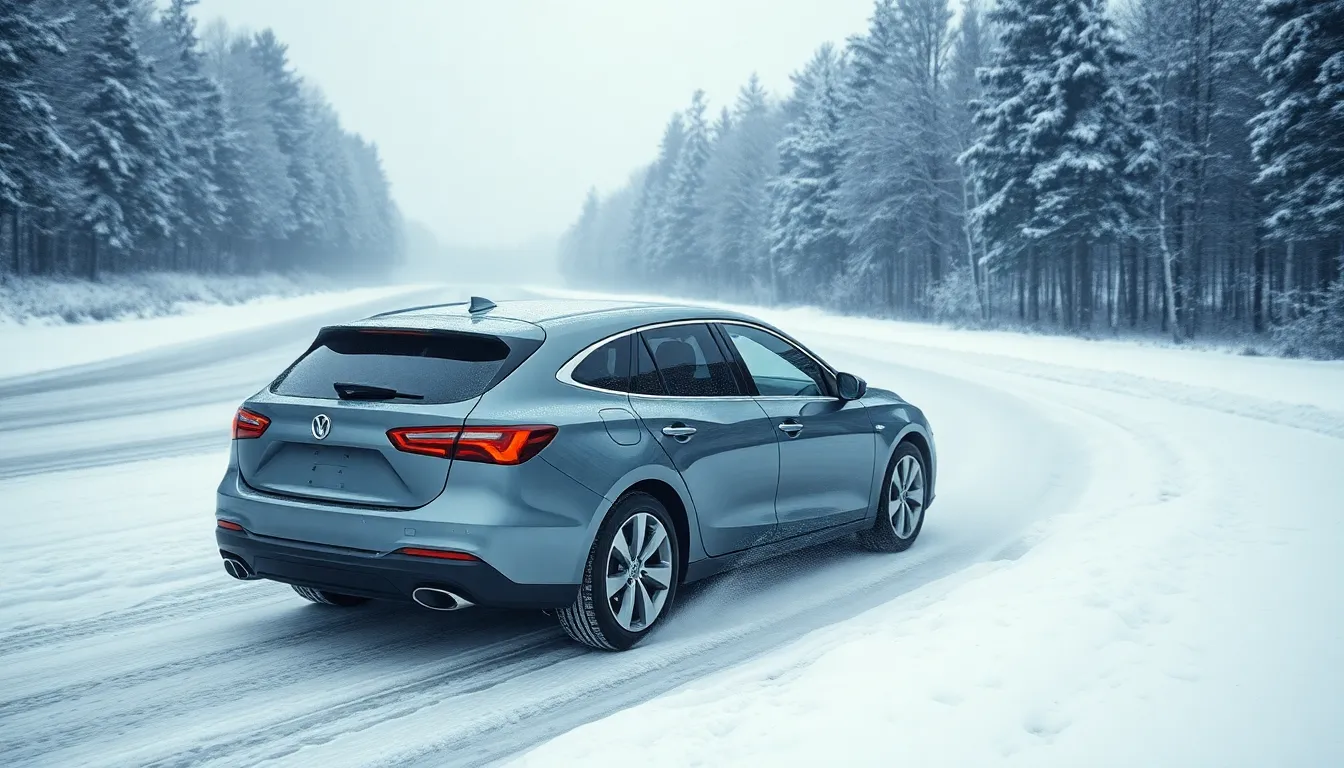
Modern vehicles come equipped with sophisticated safety technologies designed to help us navigate challenging winter conditions. We’ll explore how these systems work together to enhance our control and stability on snow and ice.
Anti-Lock Braking System (ABS) Operation
ABS prevents wheel lockup during hard braking by rapidly pulsing the brakes up to 15 times per second. This system allows us to maintain steering control while braking on slippery surfaces, which is crucial when we need to avoid obstacles on icy roads.
Feel the pulsing sensation through the brake pedal when ABS activates, and don’t pump the brakes manually. We should apply firm, steady pressure and let the system do its work. Studies show ABS reduces stopping distances on wet pavement by up to 20%, though distances may actually increase on loose snow or gravel.
Steer around obstacles while braking hard, as ABS maintains our ability to change direction. This feature becomes especially valuable when we encounter unexpected hazards like stalled vehicles or debris on winter roads.
Electronic Stability Control Benefits
ESC monitors vehicle movement through sensors that detect when we’re beginning to lose control during turns or lane changes. The system can brake individual wheels and reduce engine power within milliseconds to help us maintain our intended path.
Understeer and oversteer correction happens automatically when ESC detects these dangerous conditions. If our front wheels lose grip and the car pushes wide in a turn, ESC applies the inside rear brake to help rotate the vehicle back on course.
Winter driving statistics show ESC reduces single vehicle crashes by 49% and rollover accidents by 75% according to NHTSA data. We can’t turn off this system in most modern vehicles, as it’s designed to operate continuously for our safety.
All-Wheel Drive vs Front-Wheel Drive Performance
All-wheel drive systems distribute power to all four wheels, providing better traction when accelerating from stops on snow and ice. We’ll find AWD particularly helpful when climbing hills or handling unplowed roads where maximum traction is needed.
Front-wheel drive vehicles offer adequate winter performance with proper tires, though we’ll experience more wheel spin during acceleration. The weight of the engine over the drive wheels actually provides better traction than rear-wheel drive configurations.
Performance differences become most apparent during acceleration and hill climbing, but remember that all vehicles have similar braking and cornering limitations regardless of drive type. We still need to adjust our driving techniques and maintain appropriate speeds for conditions.
| Drive Type | Acceleration Advantage | Winter Capability | Cost Consideration |
|---|---|---|---|
| All-Wheel Drive | Excellent | Superior in deep snow | Higher purchase price, fuel costs |
| Front-Wheel Drive | Good with winter tires | Adequate for most conditions | Most economical option |
| Rear-Wheel Drive | Poor without weight | Requires extra caution | Moderate cost, challenging in snow |
Avoid Common Winter Driving Mistakes
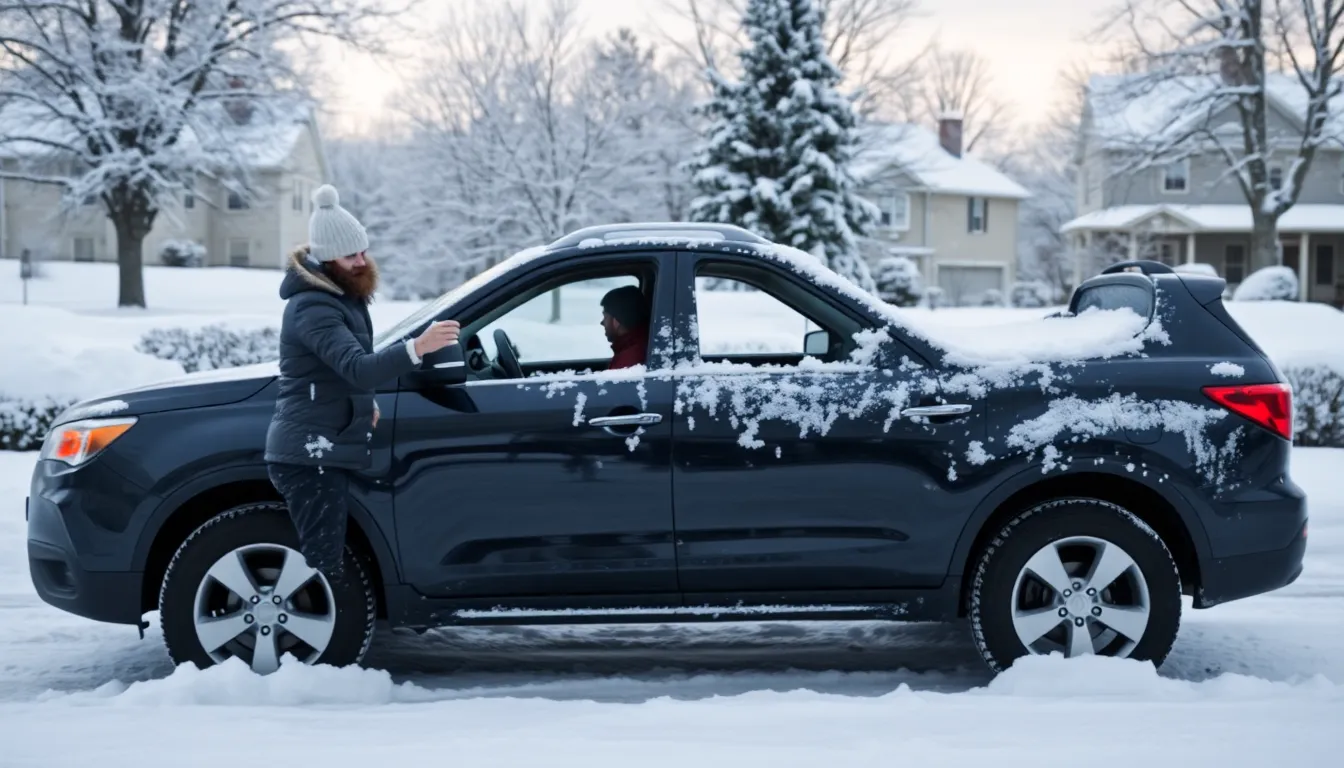
Winter driving mistakes can turn manageable snowy conditions into dangerous situations. We’ve identified the most critical errors that compromise vehicle control and passenger safety.
Overconfidence in 4WD Vehicles
Four-wheel drive doesn’t guarantee winter driving immunity, even though what many drivers believe. We often see 4WD and AWD vehicle owners driving too aggressively on icy roads, assuming their vehicles can handle any condition.
Four-wheel drive helps with acceleration and traction but doesn’t improve braking or cornering performance on ice. Your stopping distance remains the same regardless of drive type, and physics still governs how your vehicle behaves during turns on slippery surfaces.
All-wheel drive systems engage automatically but create a false sense of security. We recommend maintaining the same cautious approach in 4WD vehicles as you would in front-wheel drive cars. Reduced speeds and increased following distances remain essential even with superior traction systems.
Weight distribution in 4WD trucks and SUVs can actually worsen handling in certain conditions. These vehicles sit higher and have different center of gravity points, making them more susceptible to rollovers during emergency maneuvers on snow-covered roads.
Inadequate Vehicle Warm-Up Time
Modern engines don’t require extensive warm-up periods, but winter conditions demand additional preparation time. We see drivers rushing their pre-drive routine, which compromises both mechanical performance and safety visibility.
Your engine reaches optimal operating temperature within 30 seconds to 2 minutes of gentle driving. Extended idling wastes fuel and doesn’t warm up transmission fluid, differential oil, or other critical drivetrain components that need movement to circulate properly.
Defrosters and heating systems need 3 to 5 minutes to effectively clear windshields and windows. We recommend starting your vehicle and using this time to clear snow from lights, mirrors, and all glass surfaces rather than sitting idle in the driver’s seat.
Warming up allows you to identify potential mechanical issues before departing. Check that your heater works properly, windshield wipers move freely, and all lights function correctly during this brief preparation period.
Poor Visibility Due to Snow Coverage
Snow accumulation on vehicles creates dangerous blind spots and reduces lighting effectiveness by up to 80%. We consistently observe drivers who clear only small sections of their windshields, creating hazardous conditions for themselves and other motorists.
Clear all snow from your vehicle’s roof, hood, trunk, and windows before driving. Snow flying off your roof can blind drivers behind you or cause accidents when it slides forward onto your windshield during braking.
Remove snow from headlights, taillights, and turn signals to maintain visibility. Even thin snow layers can reduce light output significantly, making your vehicle nearly invisible to other drivers during storms or low-light conditions.
Clean your mirrors and ensure backup cameras remain unobstructed. We recommend keeping a small brush or scraper in your vehicle specifically for clearing these critical safety components throughout your journey.
Replace worn windshield wipers before winter weather arrives. Streaking or incomplete clearing creates dangerous visibility gaps, especially when combined with road salt spray and glare from oncoming headlights.
Know What to Do When Your Car Gets Stuck
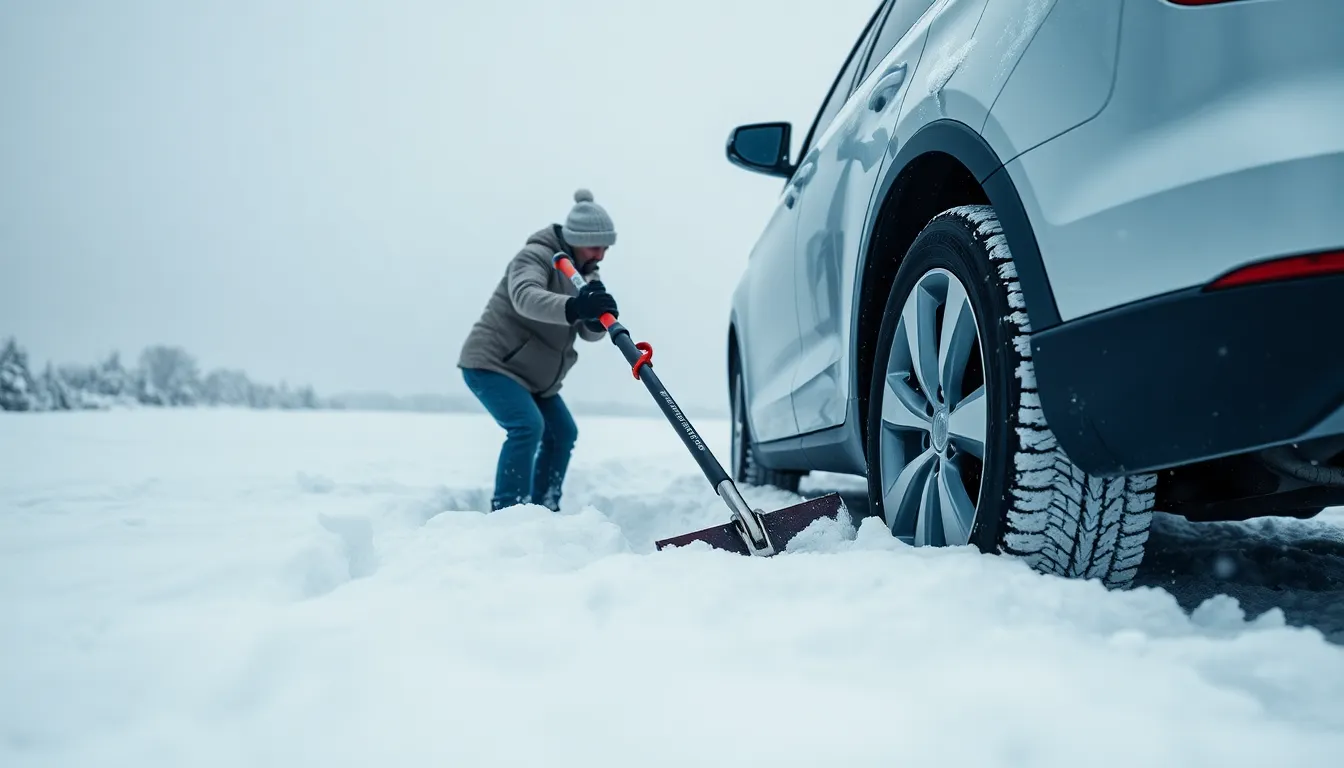
We’ve all experienced that sinking feeling when our vehicle loses traction and becomes immobilized in snow. Knowing the right techniques can transform a frustrating situation into a manageable one.
Digging Out Techniques and Tools
Start by clearing snow from around your tires using a collapsible shovel, ice scraper, or even your floor mats as makeshift digging tools. Focus on creating a clear path about three feet in front and behind your drive wheels rather than attempting to clear all the snow around your entire vehicle.
Remove snow from your exhaust pipe to prevent dangerous carbon monoxide buildup inside your car. This critical safety step takes just minutes but prevents potentially fatal consequences during extended idling periods.
Create traction channels by digging shallow trenches that follow your tire’s natural path forward and backward. These channels should be wide enough for your tires and extend several feet in both directions to give you momentum space.
Pack down loose snow in these channels using your feet or the shovel blade to create a firmer surface. Compressed snow provides better traction than fluffy powder that your tires will simply spin through.
Traction Aid Options and Usage
Apply sand, kitty litter, or road salt directly in front of your drive wheels to increase grip on icy surfaces. These materials work by increasing friction between your tires and the slippery ground beneath them.
Use your floor mats strategically by placing them under your drive wheels when you lack traditional traction aids. Rubber mats with textured surfaces work better than carpet versions for this emergency technique.
Try the rocking method by gently shifting between reverse and drive while applying minimal throttle pressure. This technique helps you build momentum gradually rather than spinning your wheels frantically in one direction.
Reduce tire pressure by 5 to 10 PSI to increase your tire’s contact patch with the ground. Lower pressure allows more tire surface to grip the snow, but remember to reinflate once you reach clear roads.
When to Call for Professional Help
Contact a tow truck when you’re stuck on a busy road or highway where attempting self extraction poses safety risks. Professional operators have the proper equipment and experience to safely remove your vehicle from dangerous locations.
Seek assistance if your car is stuck in deep snow that reaches above your bumper or if you’re dealing with ice conditions that standard traction aids can’t overcome. These situations often require winching equipment or specialized traction devices.
Call for help when you’ve been attempting extraction for more than 30 minutes without success. Prolonged spinning can overheat your transmission, damage your tires, or drain your battery to dangerous levels.
Request professional service if your vehicle is stuck at an angle that could cause it to tip or slide further into a dangerous position. Attempting to extract an unstably positioned vehicle can worsen the situation and create additional hazards.
Maintain Your Vehicle During Winter Months
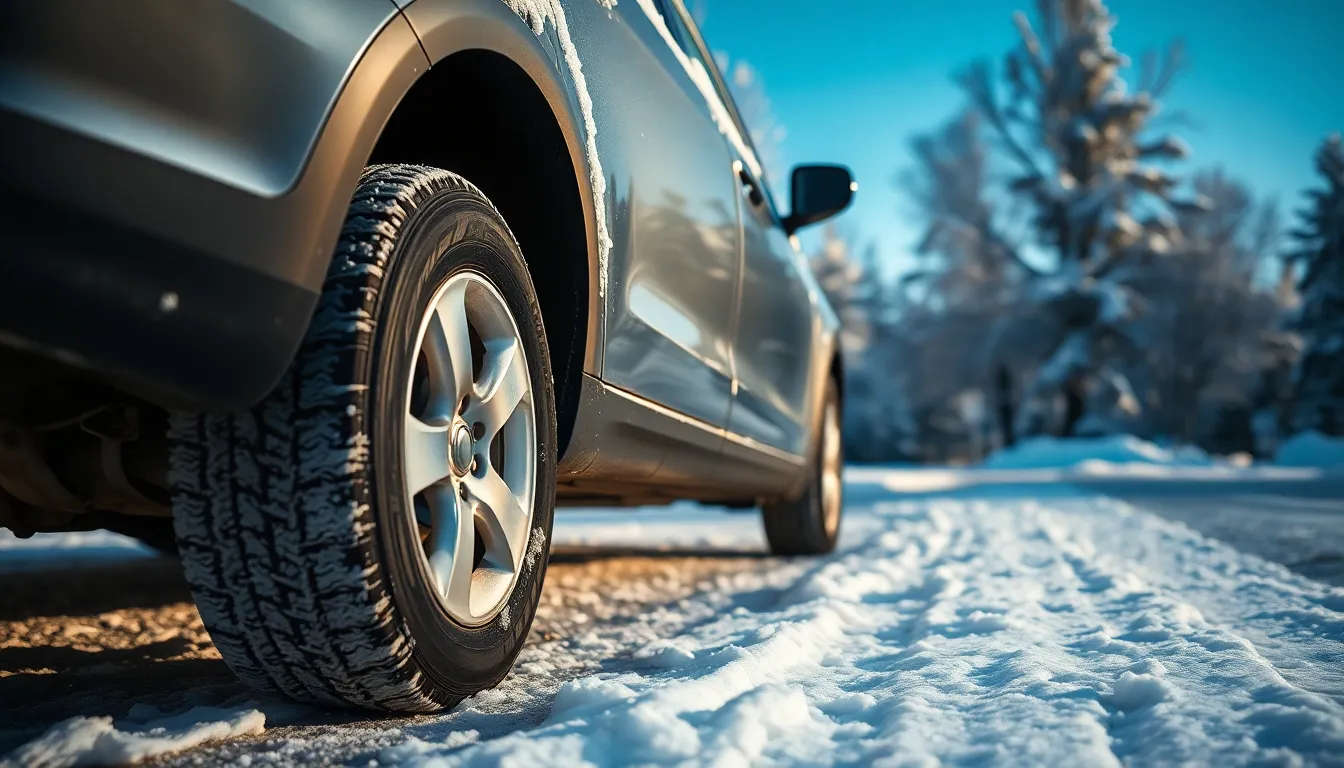
Proper winter maintenance extends beyond seasonal preparation to ongoing care throughout the coldest months. Regular attention to these key areas helps prevent costly damage and ensures reliable performance when you need it most.
Regular Cleaning to Prevent Salt Damage
Salt corrosion threatens your vehicle’s longevity more than most winter hazards combined. We recommend washing your car every two weeks during active salt application periods to prevent destructive buildup on metal components.
Focus cleaning efforts on the undercarriage where road salt accumulates most heavily. Professional undercarriage washes remove salt deposits from suspension components, brake lines, and exhaust systems that regular washing misses. Many car washes offer undercarriage services for $5-10 additional cost.
Pay special attention to door frames, wheel wells, and bumper areas where slush collects. These areas trap moisture and salt creating ideal corrosion conditions that can penetrate protective coatings within days of exposure.
Apply protective wax every 6-8 weeks during winter months to create a barrier against salt spray. Quality car wax costs $15-25 but prevents hundreds of dollars in rust damage over time by sealing paint and metal surfaces.
Tire Pressure Monitoring in Cold Weather
Temperature drops significantly impact tire pressure requiring monthly monitoring throughout winter. Tires lose approximately 1-2 PSI for every 10-degree temperature decrease making regular checks essential for safety and performance.
Check tire pressure when tires are cold preferably before driving or after sitting for three hours. Digital tire gauges provide accurate readings within 0.5 PSI and cost $10-20 at most auto parts stores.
Maintain manufacturer recommended pressure levels found on the driver’s door jamb sticker. Underinflated tires reduce traction on snow and ice while increasing stopping distances by up to 15% according to tire industry testing.
Consider nitrogen inflation for more stable pressure during temperature fluctuations. Nitrogen filled tires maintain pressure 3-4 times longer than air filled tires though the service costs $5-7 per tire at most locations.
Fuel System Protection Strategies
Fuel line freeze prevention becomes critical when temperatures drop below 20°F consistently. Add fuel system antifreeze monthly to prevent ice crystals from forming in fuel lines and injectors.
Use quality fuel additives containing isopropyl alcohol or methanol to absorb moisture in the fuel system. Products like HEET or STP Gas Treatment cost $2-4 per bottle and treat 15-20 gallons of gasoline effectively.
Keep your fuel tank at least half full during winter months to minimize condensation formation. Fuller tanks have less air space where moisture can accumulate and freeze creating fuel delivery problems.
Choose winter blend gasoline when available as it contains additives specifically formulated for cold weather performance. Winter blends typically cost the same as regular gasoline but provide better cold weather starting and reduced vapor lock issues.
Conclusion
Mastering winter driving requires a combination of proper preparation smart techniques and ongoing vigilance. We’ve covered everything from choosing the right tires to handling emergencies but remember that knowledge only helps when applied consistently.
The key to safe winter driving lies in respecting the conditions and never becoming overconfident regardless of your vehicle’s capabilities. Regular maintenance emergency preparedness and cautious driving habits will serve you well throughout the winter months.
Every snowy drive is an opportunity to practice these skills and build confidence. Stay alert stay prepared and remember that arriving safely is always more important than arriving quickly when winter weather strikes.
Frequently Asked Questions
What makes winter tires better than all-season tires for snow driving?
Winter tires use specialized rubber compounds that stay flexible in cold temperatures and feature deeper tread patterns with more biting edges. This design provides significantly better traction, shorter stopping distances, and improved handling on snow and ice compared to all-season tires, which harden in cold weather and lose grip.
How can I check if my tire tread depth is adequate for winter driving?
Use the penny test by inserting a penny into the tread groove with Lincoln’s head facing down. If you can see the top of Lincoln’s head, your tread is too shallow. For better winter performance, use the quarter test – if you can see Washington’s head, consider replacing your tires.
Are studded tires legal everywhere, and when should I install them?
Studded tire regulations vary by state. Some states prohibit them entirely, while others allow them only during specific winter months. Check your local laws before installation. Where permitted, install studded tires when temperatures consistently drop below freezing for optimal effectiveness.
What essential items should I include in my winter emergency kit?
Pack blankets, water, non-perishable food, flashlight, batteries, jumper cables, ice scraper, shovel, sand or kitty litter for traction, first aid supplies, phone charger, and warm clothing. Include tools like tire gauge and basic repair items. Store everything in a waterproof container.
How should I adjust my following distance when driving in snow?
Increase your normal following distance by at least 3-4 times on snowy roads. Use the extended three-second rule: pick a fixed object and count slowly until you pass it. On icy conditions, extend this to 8-10 seconds to allow adequate stopping time.
What’s the difference between ABS and ESC for winter driving?
ABS (Anti-Lock Braking System) prevents wheel lockup during hard braking, maintaining steering control on slippery surfaces. ESC (Electronic Stability Control) detects loss of traction and automatically applies brakes to specific wheels to prevent skids and maintain vehicle stability during turns.
Does all-wheel drive make me immune to winter driving hazards?
No, all-wheel drive only helps with acceleration and traction, not braking or steering. You can still slide on ice and snow. AWD vehicles require the same cautious driving techniques, proper tires, and extended following distances as any other vehicle in winter conditions.
What should I do if my car gets stuck in snow?
First, don’t spin your wheels excessively. Clear snow from around tires and exhaust pipe. Create traction using sand, kitty litter, or floor mats. Try the rocking technique by gently alternating between drive and reverse. If these don’t work, call for professional assistance.
How often should I wash my car during winter?
Wash your car every two weeks during winter to prevent salt and chemical damage. Focus on the undercarriage where road salt accumulates. Use touchless car washes when possible, and ensure your car is completely dry before parking to prevent freezing door locks and mechanisms.
Why does tire pressure drop in cold weather?
Tire pressure decreases by about 1-2 PSI for every 10°F temperature drop. Cold air is denser, causing the air inside tires to contract. Check tire pressure monthly during winter and inflate to manufacturer specifications, as underinflated tires reduce traction and fuel efficiency.

